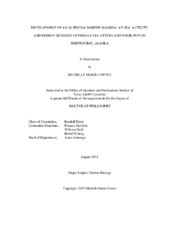| dc.contributor.advisor | Davis, Randall W | |
| dc.creator | Cortez, Michelle Marie | |
| dc.date.accessioned | 2015-10-29T19:40:24Z | |
| dc.date.available | 2017-08-01T05:37:31Z | |
| dc.date.created | 2015-08 | |
| dc.date.issued | 2015-06-05 | |
| dc.date.submitted | August 2015 | |
| dc.identifier.uri | https://hdl.handle.net/1969.1/155439 | |
| dc.description.abstract | Sea otters are the most altricial marine mammal born at sea. Female sea otters not only protect the pup from environmental and predatory threats, but also provide energy for pup activity and growth while simultaneously supporting their own elevated metabolism throughout lactation. The behavior of female sea otters and their pups was recorded during the first three months postpartum in Simpson Bay, Alaska and compiled to produce simultaneous 24-h activity budgets. Energy budgets were created from the activity budgets and published metabolic rates for certain behaviors of captive sea otters. Pups were classified into three behavioral/size categories: Category 1 (C1) 0-<4 wk old; Category 2 (C2) 4-<8 wk old; Category 3 (C3) 8-12 wk.
Energy associated with activity (Energyactivity) for all females was similar regardless of pup age (range: 10.79-11.03 MJ day-1). However, the C1 females allocated more time and energy to grooming behaviors and swimming, while C3 female allocated more time and energy to feeding. The time females spent feeding increased from 9% (C1) to 32% (C3). Energy associated with lactation (Energylactation) increased 3.5-fold, while daily food ingestion increased from 29% to 39% for C1 to C3 females (mean body mass: 20 kg).
Energy for pup growth (Energygrowth) increased 2.28-fold, while the Energyactivity increased 3.5-fold from C1 to C3 pups. C1 pups spent 83% of their day resting, which decreased to 48% for C3 pups. Time spent nursing remained constant (ca. 8%) for all pup categories, but feeding on solid food provided mainly by the female increased to 17% (C3 pups). Daily milk ingestion regardless of pup age was 7-8% of mean body mass. Our results provide a quantitative picture of the changes in female and pup behavioral patterns and energy output during the critical developmental stages. Our study revealed the energetic strategies that female sea otters use to support one of the highest metabolic rates in any adult and neonatal carnivore. These energy budgets also reflected the extreme energetic demands placed on female sea otters while caring for developing altricial pups at sea. | en |
| dc.format.mimetype | application/pdf | |
| dc.language.iso | en | |
| dc.subject | Activity Budget | en |
| dc.subject | Alaska | en |
| dc.subject | Energy Budget | en |
| dc.subject | Enhydra lutris | en |
| dc.subject | Maternal Care | en |
| dc.subject | Pup Development | en |
| dc.subject | Sea Otter | en |
| dc.title | Development of an Altricial Marine Mammal at Sea: Activity and Energy Budgets of Female Sea Otters and Their Pups in Simpson Bay, Alaska | en |
| dc.type | Thesis | en |
| thesis.degree.department | Marine Biology | en |
| thesis.degree.discipline | Marine Biology | en |
| thesis.degree.grantor | Texas A & M University | en |
| thesis.degree.name | Doctor of Philosophy | en |
| thesis.degree.level | Doctoral | en |
| dc.contributor.committeeMember | Gelwick, Frances | |
| dc.contributor.committeeMember | Neill , William H | |
| dc.contributor.committeeMember | Wursig, Bernd | |
| dc.type.material | text | en |
| dc.date.updated | 2015-10-29T19:40:24Z | |
| local.embargo.terms | 2017-08-01 | |
| local.etdauthor.orcid | 0000-0002-5039-8147 | |


